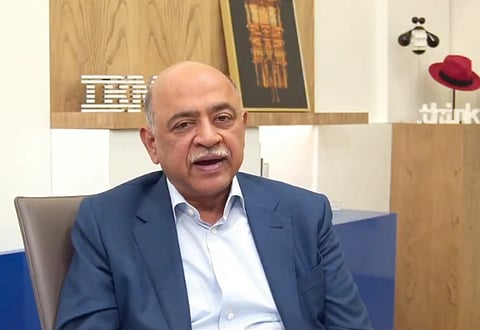‘Live every day ready to be fired’: IBM’s dramatic comeback
The fall and rise of IBM: How CEO Arvind Krishna’s shocking policy created a $242-b empire

IBM was once unstoppable.
The company, founded in 1911, gave us the PC, the ATM, floppy disc, hard drive and the barcode scanner — an empire that helped shape the modern world.
But in 2020, disaster struck.
IBM, a pioneer in computing and technology for over a century, saw its revenue plummet by $3.5 billion in a single year.
Its stock price collapsed, hitting an average $96.44 for the year, its lowest since 2011.
While tech giants like AWS and Azure soared with 30 per cent and 48 per cent growth, IBM tanked.
The industry watched in shock.
Has the legend finally fallen?
A desperate gamble
The board knew IBM needed a radical surgery.
Enter Arvind Krishna — a brilliant researcher who had spent three decades at IBM, starting at the Watson Research Center.
Krishna wasn’t a polished corporate executive.
No flashy speeches.
No empty slogans.
Just raw technical brilliance and a bold vision.
Risk-taking culture
Krishna didn’t just tweak IBM’s strategy — he tore it apart. Then rebuilt it. The company, once seen as slow and bureaucratic, became a hub of innovation.
Krishna dismantled IBM’s old corporate culture, and improved trust and security.
His ultimate aim: turn Big Blue into a risk-taking machine. And instead of just talking about it, Krishna hardwired it into IBM’s DNA.
On the issue of trust, he put his money where his mouth is: he cut management layers from 12 to 6. Then he handed front-line managers the power to approve $500,000 projects.
Secure engineering practices are fundamental to us [at IBM]. It‘s how we build our mainframe. It’s how we build our software. It’s how we build Linux. So you’ve got to go do that. And we work very deeply, by the way, with all of the agencies, both government and private sector, who do these things to try to make sure they stay ahead of it, and stay ahead of the vulnerabilities.Arvind Krishna, Chairman and CEO, IBM
‘No fault’ policy
And he introduced a “no-fault” policy — where failed projects weren’t punished but seen as fuel for learning.
Then, the real magic happened.
Innovation exploded.
Patent applications surged by 27%.
Employees logged over 33 million hours of learning in 2022.
A company once paralysed by fear of failure was now “failing forward” — and learning faster than ever.
Krishna’s radical mantra? 'Live everyday ready to be fired'
That single mindset shift did something extraordinary. It created psychological safety.
Suddenly, IBM’s best minds felt free to:
Take bold risks
Challenge outdated ideas
Propose radical solutions
The fear of failure vanished — and IBM’s culture transformed from conservative to cutting-edge. IBM's market capitalisation (as of February 14) stood at $241.59 billion, while its year-to-date stock price stood at $261.28, up 19 per cent since January 2, 2025.
ThinkLab
Think Lab, a platform where employees could pitch ideas, became Krishna's brainchild.
In the first year alone, it generated 5,000 concepts — 10 per cent received immediate funding. IBM had stopped playing it "safe". And that’s exactly what saved it.
The numbers spoke for themselves:
Profit margins jumped from 49.3% to 53.4%
Cloud revenue surged to $26.3 billion—37% of total earnings
Stock prices, stagnant for years, shot up by 40% (2024)
More than a comeback
Today, IBM isn’t just surviving. It’s leading again.
It is pioneering quantum computing breakthroughs
Developing AI systems capable of debating humans
Powering industries with cutting-edge cloud solutions
Amid the pandemic, IBM shares jumped 16.8 per cent in 2021 (to $110), 10.7 per cent in 2022 (to $120.05), 21.8 per cent in 2023 (to $131.37), and 39.2 per cent in 2024 (to $190.96).
Since January 2025, the IBM stock price is up nearly 20 per cent to $261.28.
The real lesson?
IBM continues to push boundaries in AI, quantum computing, and semiconductor technology.
In a world where technology evolves at lightning speed, survival depends on adaptability. Krishna didn’t just rescue IBM — he led Big Blue to be future-proof.
Sign up for the Daily Briefing
Get the latest news and updates straight to your inbox



